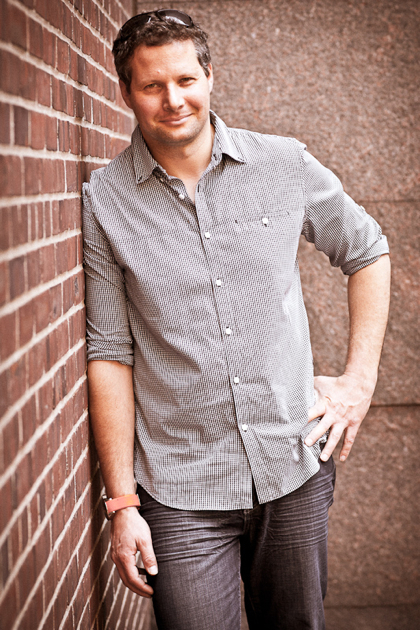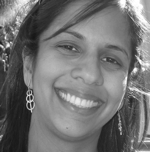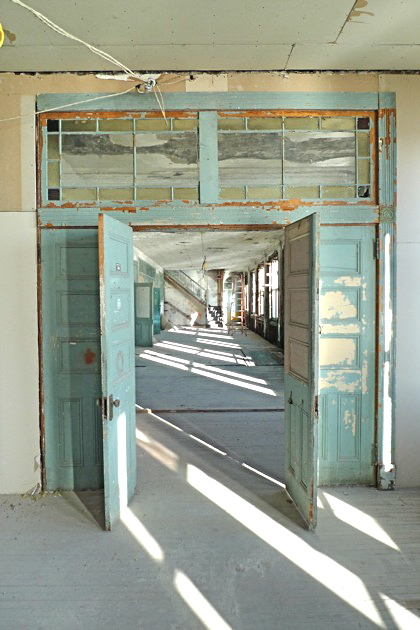Categories
Left column house ads
From Arad to Tribeca
June 23, 2011 People
 It was January 2002, and New York City was still reeling from the 9/11 attacks and a deadly plane crash. But despite his friends’ warnings, nothing could stop 26-year-old Lior Schapiro from moving here to become an architect. The city could not have been more different from his small desert town in Israel, and he recently sat down for a frank discussion about his early days in New York, why the U.S. isn’t necessarily the land of the free, and how meeting his wife was the single best moment in his adopted city. (Portrait by Ilan Klein Photography.)
It was January 2002, and New York City was still reeling from the 9/11 attacks and a deadly plane crash. But despite his friends’ warnings, nothing could stop 26-year-old Lior Schapiro from moving here to become an architect. The city could not have been more different from his small desert town in Israel, and he recently sat down for a frank discussion about his early days in New York, why the U.S. isn’t necessarily the land of the free, and how meeting his wife was the single best moment in his adopted city. (Portrait by Ilan Klein Photography.)
What brought you to the U.S.?
My two friends and I, all from Israel, moved to New York City to attend the architecture program at City College.
You were 26 at the time. Was it a graduate program?
No, undergraduate. In Israel, students perform their army service requirement after high school, and then they usually spend some time traveling. Most people enter college around the age of 22 or 23.
That certainly must have been interesting for you, sitting in class with 18 year-olds.
Yes, starting so early certainly makes for a very different way of thinking. In Israel, we have already given some thought to what we want to do with our lives, so we are focused. Here, everyone is so young when they start college. I remember a philosophy professor asking our class if we could take a trip anywhere, where we would go. Someone yelled out “Six Flags”! I was just shocked. There are so many wonderful places to see in the world, and that’s what he chose?
Were there any cultural difficulties you faced in the beginning?
One issue is that in Israel, paying for things in installments is quite common. Here it barely exists. You need a computer, you pay in full. Paying tuition for the year, pay in full. That was difficult for me in the beginning.
What do you like about living in New York?
The culture. I grew up in Arad, a remote town in the desert in Israel. Culture was not so accessible. I love music, but before the Internet it was very difficult to find records of the songs you heard on the radio. There weren’t options for museums and other cultural things. But on the other hand I developed a relationship with nature. I love the desert scenery and my house was on the edge of town, one step away from the desert. There was lots of open space and I never felt cramped.
Was moving here to a tiny apartment quite a shock?
Yes, New York was culture shock in that sense. But it was also kind of a renaissance for me in terms of the cultural offerings. Plus, I lived on the West Side and I spent a lot of time going to the Barnes & Noble and Tower Records. There is so much to see in every square foot of the city, and I love that about New York.
What made you move downtown?
It was 2004 and my architecture class was assigned a project to renovate Pier A, the old pier at the southern edge of Battery Park City. I took a walk around the neighborhood and ended up on the Hudson River esplanade. It was beautiful, and I discovered the rents were low because people were still worried about living downtown. I told my girlfriend—now my wife—about it, and later that year we moved into Gateway Plaza. We loved the neighborhood and decided to buy in Tribeca in 2007.
What do you think of Tribeca?
Living in Tribeca is like living in history. My wife and I love walking the streets, noticing the details on the old buildings and seeing what was there before. It’s very European, and I love that it’s a lively, friendly neighborhood with accessible transportation. You can get apartments with great water views and lots of daylight here.
Is there anything about the U.S. that you’re not too excited about?
There is democracy here, definitely, but I don’t like when people refer to the U.S. as the land of freedom and opportunity. There are so many restrictions here. For example, a few years ago I was doing some stretches in the courtyard at Gateway Plaza after a run and a security guard came over and told me I couldn’t sit on the ground. I asked why there were benches then, and he told me I could sit on the benches, but not on the ground. I argued with him and he actually called another security guard over. There is a lot of rigidity and formality, and the rules are often nuanced.
What are some of the differences between Israel and the U.S.?
Israel is a true melting pot, and different groups mix with one another. Here we’re still in the beginning. Every group is here, but every group has its own section of town and they’re not exactly mingling. It’s a melting pot, not a fondue.
What do you miss about Israel?
I still have a lot of good friends there, and I miss them a lot. It’s easier to make friends there, I think. There’s more openness and acceptance of new people. I also miss Israeli humor. There’s no concept of political correctness there, and that makes the humor edgier and funnier. Here everyone is so careful. I don’t think the late night shows—Leno, Letterman—are funny at all. And why are they all wearing suits? Why the formality?
Where do you go in NYC to remind you of home?
Hummus Place restaurants. It’s a chain and the closest one is in the West Village. Also the Holyland Market in the East Village. It sells all kinds of authentic Israeli products. It has all the brands that I grew up with.
What was your favorite New York City moment?
Meeting my wife. She really completed my life here and I enjoy being with her so much. She is American, and she moved to the city five years before I did. I knew the area around City College, but I had never been to Soho, for example. She really introduced me to the city, and to the theater and independent films. Oh, and Mexican food. I had never had it before. She got me to try it and I loved it.
Did you propose to her in New York?
Yes, in Central Park. We had a picnic there on a Friday night.
You had a picnic in Central Park at night?
I did my military service in Gaza. Central Park at night is nothing.
Are there any times that you still feel like an outsider?
Strangely enough, the process to become a citizen was the time I felt most like an outsider. Any time I had to go into federal buildings I felt humiliated. The way the officers speak to you, the way they treated some of the older people, the 50 year-olds and 60 year-olds, was terrible. They feel that this is the best country to live in, so you should be grateful that you’re here. There are lots of great things about this country, but it’s as if they are trying to take your roots and plant them somewhere else. I am happy to be here, and feel comfortable and settled, but I will always be Israeli and that will never change.
What will be different for your kids growing up in the U.S. compared to your experience in Israel?
In Israel, I was allowed to be out of the house by myself at a very young age. At six, I was walking to school alone. No one worried about kidnappers or pedophiles. In New York, kids don’t go anywhere by themselves. On the other hand, my kids will be exposed to culture at a much younger age than I was.
How does a young boy from the desert develop an interest in architecture?
In Arad, my hometown in Israel, houses fit nicely into their surroundings. I was always fascinated by them and would spend hours with my Legos, trying to recreate them.
And are you working as an architect now?
After graduation, I worked for five years with an architecture firm and worked on two luxury high rises in New York. Then in November 2010, I left to start my own kids’ furniture company. I have young twin boys, and I think most cribs look like prison cells. I’ve come up with different textures and patterns to break up the rigidity and make them friendlier spaces for kids.
When can we check out your kids’ furniture?
I’ve done the designs, but I still need to get all the necessary federal approvals. I expect to be selling them around the end of 2011.
 About the author: Anojja Shah (left) is a Tribeca mom who spends her days running after a feisty 3-year-old. In past lives she worked as a journalist and on Wall Street in equity research. This Q&A is the fifth in her series of interviews with immigrants who live and/or work in Tribeca.
About the author: Anojja Shah (left) is a Tribeca mom who spends her days running after a feisty 3-year-old. In past lives she worked as a journalist and on Wall Street in equity research. This Q&A is the fifth in her series of interviews with immigrants who live and/or work in Tribeca.
Previous “I → NY” interviews:
••• From Fujian to Tribeca: Kevin Red
••• From Tokyo to Tribeca: Masako Chiba
••• From East Java to Tribeca: Rinta Juwana
••• From Montreal to Tribeca: Sarah Mlynowski
Comments are closed.
Subscribe
Subscribe to the TC Newsletter


















